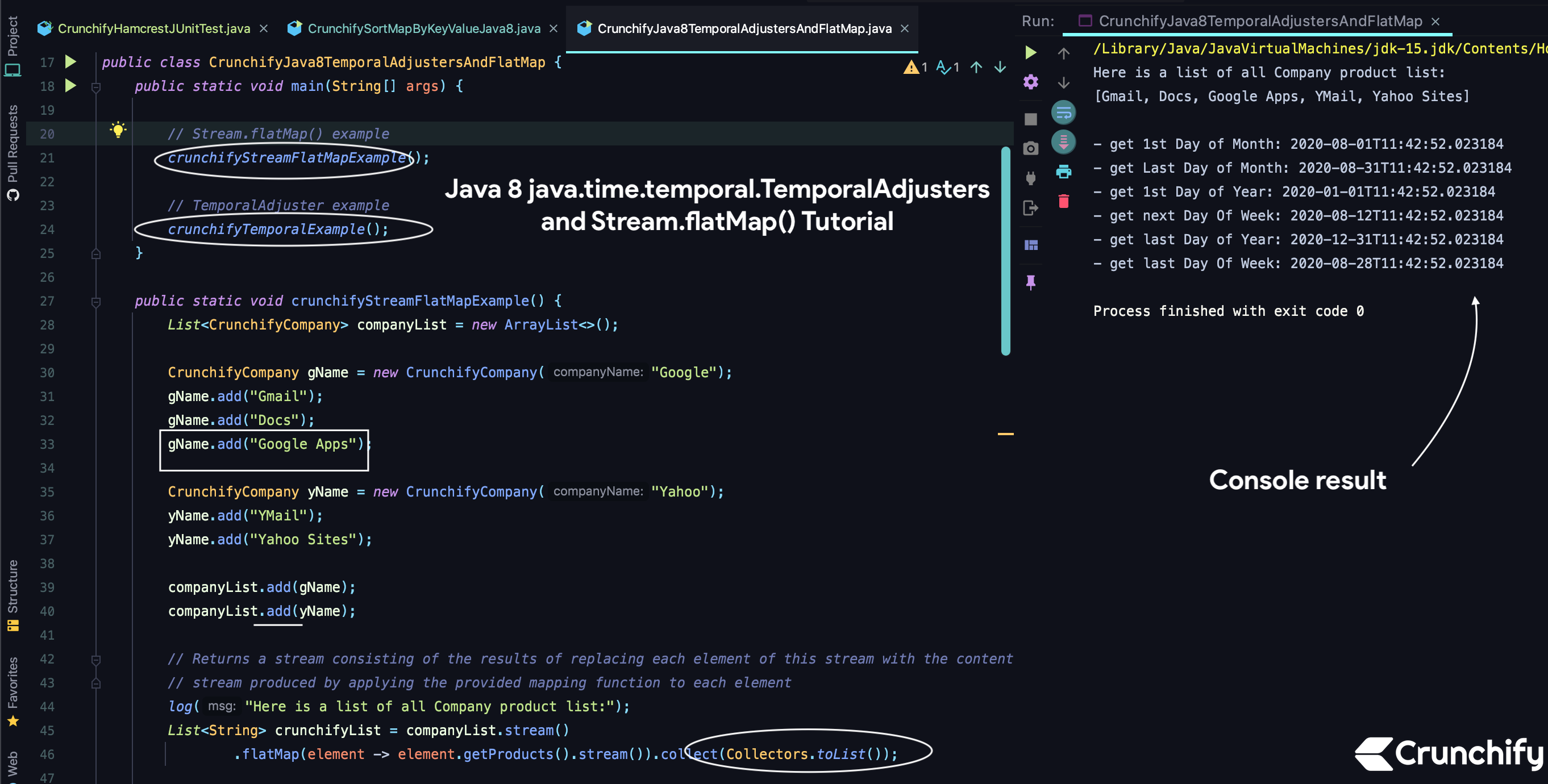
It’s been almost 2 years Java 8 was released, March 2014. I’m sure most of the companies still using Java 7 with Apache Tomcat in their production environment but recently it’s picking up some momentum.
As most the companies still using Java 7 there are quite a few features unnoticed by the world.
Sometime back we have written a detailed article on Java 8 Stream API and Lambda Expression. In this tutorial we will go over java.time.temporal.TemporalAdjusters and flatMap() example.
TemporalObjects
What are tempoalObjects in Java? It’s framework level interface dealing with date and time object, mainly read-only objects which provides access in generic manner.
TemporalAdjusters
TemporalAdjusters are a key tool for modifying temporal objects. There are two ways you could use TemporalAdjuster.
- Invoke the method on the interface directly
- use Temporal.with(TemporalAdjuster)

Stream.flatMap()
Java map and flatMap can be applied to a Stream<T> and they both return a Stream<R>. What is a difference?
mapoperation produces one output value for each input valueflatMapoperation produces an arbitrary number (zero or more) values for each input value
Let’s get started on Tutorial
- Create class CrunchifyJava8TemporalAdjustersAndFlatMap.java
- We will create two simple methods
- crunchifyStreamFlatMapExample
- crunchifyTemporalExample
- All details are provided in each method itself as comment
- Run the program and checkout result
- make sure you have setup JDK 8 in Eclipse environment
CrunchifyJava8TemporalAdjustersAndFlatMap.java
package crunchify.com.tutorials;
import java.time.DayOfWeek;
import java.time.LocalDateTime;
import java.time.temporal.TemporalAdjusters;
import java.util.ArrayList;
import java.util.HashSet;
import java.util.List;
import java.util.Set;
import java.util.stream.Collectors;
/**
* @author Crunchify.com
* Java 8 java.time.temporal. TemporalAdjusters and Stream.flatMap() Tutorial
*/
public class CrunchifyJava8TemporalAdjustersAndFlatMap {
public static void main(String[] args) {
// Stream.flatMap() example
crunchifyStreamFlatMapExample();
// TemporalAdjuster example
crunchifyTemporalExample();
}
public static void crunchifyStreamFlatMapExample() {
List<CrunchifyCompany> companyList = new ArrayList<>();
CrunchifyCompany gName = new CrunchifyCompany("Google");
gName.add("Gmail");
gName.add("Docs");
gName.add("Google Apps");
CrunchifyCompany yName = new CrunchifyCompany("Yahoo");
yName.add("YMail");
yName.add("Yahoo Sites");
companyList.add(gName);
companyList.add(yName);
// Returns a stream consisting of the results of replacing each element of this stream with the contents of a mapped
// stream produced by applying the provided mapping function to each element
crunchifyLog("Here is a list of all Company product list:");
List<String> crunchifyList = companyList.stream()
.flatMap(element -> element.getProducts().stream()).collect(Collectors.toList());
crunchifyLog(crunchifyList.toString());
}
private static void crunchifyLog(String msg) {
System.out.println(msg);
}
static class CrunchifyCompany {
private String companyName;
private final Set<String> products;
public CrunchifyCompany(String companyName) {
this.setCompanyName(companyName);
this.products = new HashSet<>();
}
public void add(String animal) {
// add(): Adds the specified element to this set if it is not already present (optional operation).
// More formally, adds the specified element e to this set if the set contains no element e2 such that Objects.equals(e, e2).
// If this set already contains the element, the call leaves the set unchanged and returns false.
this.products.add(animal);
}
public Set<String> getProducts() {
return products;
}
public String getCompanyName() {
return companyName;
}
public void setCompanyName(String companyName) {
this.companyName = companyName;
}
}
public static void crunchifyTemporalExample() {
// A date-time without a time-zone in the ISO-8601 calendar system
// String time = LocalDateTime.now().format(DateTimeFormatter.ISO_OFFSET_DATE_TIME);
// Let's return currentitme - 1 year
LocalDateTime crunchifyTime = LocalDateTime.now().minusYears(1);
// TemporalAdjusters: Adjusters are a key tool for modifying temporal objects
crunchifyLog("\n- get 1st Day of Month: " + crunchifyTime.with(TemporalAdjusters.firstDayOfMonth()));
// Returns the "last day of month" adjuster
crunchifyLog("- get Last Day of Month: " + crunchifyTime.with(TemporalAdjusters.lastDayOfMonth()));
// Returns the "first day of year" adjuster
crunchifyLog("- get 1st Day of Year: " + crunchifyTime.with(TemporalAdjusters.firstDayOfYear()));
// Returns the next day-of-week adjuster
crunchifyLog("- get next Day Of Week: "
+ crunchifyTime.with(TemporalAdjusters.next(DayOfWeek.WEDNESDAY)));
// Returns the "last day of year" adjuster
crunchifyLog("- get last Day of Year: " + crunchifyTime.with(TemporalAdjusters.lastDayOfYear()));
// Returns the last in month adjuster
crunchifyLog("- get last Day Of Week: "
+ crunchifyTime.with(TemporalAdjusters.lastInMonth(DayOfWeek.FRIDAY)));
}
}
Output:
Here is a console result. Just run above Java program and you will see result like below.
Here is a list of all Company product list: [Gmail, Docs, Google Apps, YMail, Yahoo Sites] - get 1st Day of Month: 2015-01-01T12:07:11.980 - get Last Day of Month: 2015-01-31T12:07:11.980 - get 1st Day of Year: 2015-01-01T12:07:11.980 - get next Day Of Week: 2015-01-14T12:07:11.980 - get last Day of Year: 2015-12-31T12:07:11.980 - get last Day Of Week: 2015-01-30T12:07:11.980
